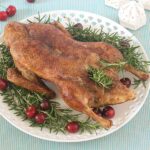Steam Oven Roast Duck
Roasting duck in a steam oven keeps the meat tender and juicy. You might never go back to your regular oven again!This will feed 8 if it's part of a larger meal, or about 6 if it's the only meat you're serving.
Servings: 8
Calories: 1036kcal
Ingredients
- 4.5 lb whole duck 2.1kg, fresh or completely thawed. If your duck is a different weight you may need to adjust cooking time
- 1 ½ tsp flaky sea salt
- 1 ½ tsp ground cinnamon
- 2 sprigs rosemary
- 1/2 orange chopped into a few pieces
Instructions
- Set your oven to 340⁰F/170⁰C, combination steam setting. If your oven has variable steam settings, use 50-60%. If not, don't worry! Just set to combi steam at the correct temperature and the oven will figure out the humidity for you.
- Rinse the cavity of the duck and pat the whole thing dry with paper towels. If your duck came in a sweaty plastic bag I’d recommend doing this the day before, or at least a few hours out, and returning it uncovered to the fridge so it can dry out a little.
- Sprinkle a little of the salt inside the cavity then rub the rest of the salt and the cinnamon all over the skin. Put the rosemary and orange pieces into the cavity (don’t be tempted to stuff too much orange in there, you want enough free space for heat to circulate and cook it properly). Use a skewer to poke several holes into the fattiest parts of the skin around the cavity, neck and thighs – this will help the fat to render out during cooking.
- Put the duck on a large perforated stainless steel tray and slide it onto the middle shelf of the oven. Put a solid tray on the shelf underneath it to catch the juices and fat (there’s going to be plenty and you do not want that on the floor of your oven!). Cook for 50 minutes.
- When the 50 minutes are up, change your oven setting to 430⁰F/220⁰C, fan forced/convection (no steam). Take the duck out of the oven and give it a quick baste with all that lovely rendered fat, then return and cook for a further 15 minutes. At this point the skin should be golden and crispy and the juices should run clear when tested with a skewer (the internal temperature at the thickest point should be 167⁰F/75⁰C if you're testing with a thermometer).
- Rest the duck in a warm place for at least 20 minutes before carving – if you want to ‘hold’ it for longer, cover with foil to help retain the heat (see headnote about crispy skin in this case). I think it’s perfectly acceptable to serve this at a warm room temperature, in which case you could leave it to rest for anywhere up to an hour and a half before carving.
Notes
- In Australia Christmas equals cherry season, which is great news as far as duck is concerned because they’re a fantastic pairing. I’ve done a few roasted-cherry sauces to serve with duck, which are lovely, but I keep coming back to simple fresh cherries because uncooked, they have a vibrance and slight tartness which goes so well with the rich meat (pitted and tossed in a little orange juice is my favourite). If you’re in the Northern hemisphere’s wintery depths my pick for a fresh accompaniment would be a little composed salad of mandarin/clementine segments, flat leaf parsley and very finely sliced red onion.
- My duck is spot on with the times below, but because every steam oven is a little different, you may wish to check for done-ness 10 minutes earlier just in case. I’d suspect those with pressurized-cavity steam ovens (definitely Miele, I think V-Zug and I’m sure there are several others) would need a few minutes less for cooking time.
- If you find after it’s rested that your duck skin is less than crispy, you can pop it back into a blistering hot dry oven (230⁰C) for no more than 5 minutes just before serving. You don’t want to cook the meat any further or ruin all that lovely resting you’ve done, so as soon as the skin starts to sizzle again, take it out.
- If you don’t have a perforated tray with your oven, just set the duck on a rack over a solid roasting tray. The main thing is just to get it sitting higher than the tray so the bottom half doesn’t stew in the pan juices and fat.
Nutrition
Calories: 1036kcal | Carbohydrates: 1g | Protein: 29g | Fat: 50g | Saturated Fat: 17g | Cholesterol: 194mg | Sodium: 597mg | Potassium: 548mg | Fiber: 1g | Sugar: 1g | Vitamin A: 447IU | Vitamin C: 12mg | Calcium: 36mg | Iron: 6mg
